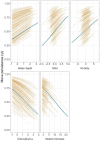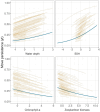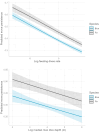Ecological drivers of movement for two sympatric marine predators in the California current large marine ecosystem
- PMID: 40102967
- PMCID: PMC11917063
- DOI: 10.1186/s40462-025-00542-9
Ecological drivers of movement for two sympatric marine predators in the California current large marine ecosystem
Abstract
Background: An animal's movement reflects behavioral decisions made to address ecological needs; specifically, that movement will become less directional in regions with high prey availability, indicating foraging behavior. In the marine realm, animal behavior occurs below the sea surface and is difficult to observe. We used an extensive satellite tagging dataset to explore how physical and biological habitat characteristics influence blue (Balaenoptera musculus) and fin (B. physalus) whale movement and foraging behavior in the California Current Ecosystem across four known bioregions.
Methods: We fitted movement models to 14 years of blue whale satellite tracking data and 13 years of fin whale data to characterize their movement persistence, with higher move persistence values representing more directional movement and lower move persistence values representing less directional movement. Models were evaluated against a range of physical and biological environmental predictors to identify significant correlates of low move persistence (i.e., presumed intensified foraging behavior). We then used data from a subset of sensor-equipped tags that monitored vertical behavior (e.g., dive and feeding), in addition to movement, to test the relationship between vertical behavior and movement persistence.
Results: Low move persistence was strongly correlated with shallower water depth and sea surface height for both species, with additional effects of chlorophyll-a concentration, vorticity and marine nekton biomass for blue whales. Data from sensor-equipped tags additionally showed that low move persistence occurred when whales made more numerous feeding dives. Temporal patterns of bioregion occupancy coincided with seasonal peaks in productivity. Most blue whale low-move-persistence movements occurred in the northern, nearshore bioregion with a late-season peak in productivity and were evenly distributed across all bioregions for fin whales.
Conclusions: We demonstrated that low move persistence is indicative of increased feeding behavior for both blue and fin whales. The environmental drivers of low move persistence were similar to those previously identified for survey-based species distribution models, linking environmental metrics to subsurface behavior. Occupancy and movement behavior patterns across bioregions indicate both species moved to exploit seasonal and spatial variability in productivity, with blue whales especially focusing on the bioregion of highest productivity during late summer and fall.
Keywords: Biologging; Blue Whale; California current; Feeding behavior; Fin Whale; Move persistence; Movement behavior; Satellite tags.
© 2025. The Author(s).
Conflict of interest statement
Declarations. Ethics approval and consent to participate: The activities reported in this study involving the deployment of implantable tags on large whales were carried out under the authorization of the U.S. National Marine Fisheries Service Marine Mammal Protection Act and Endangered Species Act scientific research permits and further reviewed and approved by the Institutional Animal Care and Use Committees. For all blue whale tagging and OSU fin whale tagging, the relevant permits were NMFS permit #841 (1998), #369–1440 (1999–2004), #369–1757 (2005–2013), and #14856 (2014–2018) and Oregon State University Institutional Animal Care and Use Committee permit #4495 and #4884. Fin whale tagging by MarEcoTel was conducted under NOAA research permits 540–1811 and 16111 and approved by Cascadia Research Collective’s Institutional Animal Care and Use Committee. Consent for publication: Not applicable. Competing interests: The authors declare no competing interests.
Figures







Similar articles
-
Ecological correlates of blue whale movement behavior and its predictability in the California Current Ecosystem during the summer-fall feeding season.Mov Ecol. 2019 Jul 18;7:26. doi: 10.1186/s40462-019-0164-6. eCollection 2019. Mov Ecol. 2019. PMID: 31360521 Free PMC article.
-
From Chilean Patagonia to Galapagos, Ecuador: novel insights on blue whale migratory pathways along the Eastern South Pacific.PeerJ. 2018 Apr 30;6:e4695. doi: 10.7717/peerj.4695. eCollection 2018. PeerJ. 2018. PMID: 29736336 Free PMC article.
-
The development of an intermediate-duration tag to characterize the diving behavior of large whales.Ecol Evol. 2016 Dec 20;7(2):585-595. doi: 10.1002/ece3.2649. eCollection 2017 Jan. Ecol Evol. 2016. PMID: 28116055 Free PMC article.
-
Is it 'boom times' for baleen whales in the Pacific Arctic region?Biol Lett. 2016 Sep;12(9):20160251. doi: 10.1098/rsbl.2016.0251. Biol Lett. 2016. PMID: 27601724 Free PMC article. Review.
-
The largest of August Krogh animals: Physiology and biomechanics of the blue whale revisited.Comp Biochem Physiol A Mol Integr Physiol. 2021 Apr;254:110894. doi: 10.1016/j.cbpa.2020.110894. Epub 2021 Jan 5. Comp Biochem Physiol A Mol Integr Physiol. 2021. PMID: 33418052 Review.
Cited by
-
The role of oceanographic scales in shaping highly mobile marine predator distributions.Sci Rep. 2025 Jul 2;15(1):23235. doi: 10.1038/s41598-025-06486-9. Sci Rep. 2025. PMID: 40603449 Free PMC article.
References
-
- Charnov EL. Optimal foraging, the marginal value theorem. Theor Popul Biol. 1976;9(2):129–36. - PubMed
-
- Fretwell SD, Lucas HL. On territorial behavior and other factors influencing habitat distribution in birds. Acta Biotheor. 1969;19(1):16–36.
-
- Abrahms B, Aikens EO, Armstrong JB, Deacy WW, Kauffman MJ, Merkle JA. Emerging perspectives on resource tracking and animal movement ecology. Trends Ecol Evol. 2020;36(4):308–20. - PubMed
-
- Riotte-Lambert L, Matthiopoulos J. Environmental predictability as a cause and consequence of animal movement. Trends Ecol Evol. 2020;35(2):163–74. - PubMed
LinkOut - more resources
Full Text Sources

